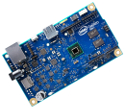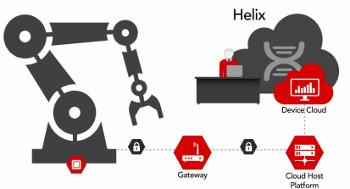Wind blows Helix Cloud, Pulsar Linux, Rocket RTOS toward IoT
Nov 4, 2015 — by Eric Brown 3,064 views
Wind River unveiled a “Helix Cloud” platform for IoT development and management, plus two small-footprint OSes: a “Rocket” RTOS and “Pulsar Linux.”
Intel subsidiary Wind River has released Wind River Pulsar Linux, an IoT-oriented version of its commercial Wind River Linux distribution, as well as a new Wind River Rocket RTOS. Both of these embedded OSes are designed to work with a newly unveiled Wind River Helix Cloud platform for developing, testing, monitoring, and analyzing cloud-connected IoT applications. Wind River Helix Cloud is available in App, Lab, and Device versions, and is said to provide “anytime, anywhere access to development tools, virtual labs, and deployed devices.” (see farther below).

Wind River Pulsar Linux architecture
(click image to enlarge)
Like Wind River Linux, Pulsar Linux is based on Yocto Project code with support for 32- and 64-bit x86 and ARM architectures. The binary-delivered distribution is a “small, secure, performant, and manageable image that is certified and bundled with COTS platforms,” says Wind River.
 MinnowBoard Max |
Wind River Pulsar Linux will initially be pre-installed on Intel’s Atom-based, open spec MinnowBoard Max SBC, as well as three Avnet boards equipped with Xilinx Zynq-7000 ARM/FPGA SoCs: the PicoZed computer-on-module, the MicroZed (both COM and SBC models), and the Avnet Mini-ITX development kit.
— ADVERTISEMENT —
Pulsar Linux provides a small, reconfigurable kernel, user space, and file system, with support for virtualization and containers. Ongoing security patches are provided, and all transfers, from secure boot to middleware and applications, are made via a certified repository feed.
 Avnet MicroZed SBC |
Although Pulsar Linux is designed as a preconfigured distribution optimized for particular hardware platforms, developers can also go to Github to download the latest certified images, build system, cross toolchain, “and all layers and packages needed to rebuild,” says Wind River. The distribution is provided with complete source code.
The free Wind River Rocket RTOS (real-time operating system) is designed to run on 32-bit microcontrollers with as little as 4KB of memory. Rocket appears to be based on, or is perhaps the new name for, the small-footprint, open source Viper RTOS derived from Wind River’s proprietary VxWorks RTOS. Earlier this year, Viper was introduced for the previously deactivated Intel Quark processor on the Intel Edison module, which is primarily driven by Linux running on an Intel Atom SoC.
 Intel Galileo Gen 2 |
Rocket, will be pre-installed as an option for Intel’s Quark-based Galileo Gen 2, which normally uses Linux. Rocket will also ship on Seeed’s Grove Starter Kit Plus version of the Intel IoT Edition for Intel Galileo Gen 2 and Edison, and will soon be offered on a Freescale Freedom K64F development board featuring a Kinetis K64, K63 or K24 MCU.
Wind River Helix Cloud
Both Wind River Pulsar Linux and Wind River Rocket are designed to work seamlessly with the new Wind River Helix Cloud, a software-as-a-service (SaaS) platform for developing, testing, and managing IoT applications. Part of the larger Wind River Helix portfolio of IoT-related software, Helix Cloud aims to simplify embedded app development with a cloud-based environment that is particularly suitable for far-flung, collaborative development teams.

Wind River Helix Device Cloud conceptual diagram
(click image to enlarge)
Wind River Helix Cloud builds upon earlier IoT platforms such as Wind River Intelligent Device Platform XT, which works with the Intel Gateway Solutions for IoT hardware/software reference platform from Wind River parent company Intel. Helix Cloud joins other cloud-based IoT management solutions such as Amazon’s new AWS IoT platform, which similarly works with IoT endpoint development platforms based on preconfigured Linux hacker boards, in this case the BeagleBone Green and Intel Edison.
Wind River Helix Cloud versions include:
- Wind River Helix App Cloud — This cloud-based development environment for building IoT applications ships with Wind River Rocket as the default, but also works with Pulsar Linux. Helix App Cloud offers a single location for streamlined management of software developer kits (SDKs), hardware targets, and users. The platform offers a web-based GUI environment that lets you build and manage multiple SDKs on a variety of hardware platforms, with deployment available on public or on-premises servers, as well as virtual private clouds.

Wind River Helix Device Cloud development environment
(click image to enlarge)
Debugging tools are provided for C, C++, and Node.js, featuring access to remote device hardware targets. Other features include project management and collaboration tools, as well as an IDE with an ACE-based editor, Docker-based workspaces, preconfigured build environments, and integration with Git.A free version is available, offering predefined SDKs for setups on a shared public server with community support, and a 250MB storage limit. A paid version due in December, will let developers add custom SDKs, and will offer user and permissions management. A future versions will enable management of real and virtual hardware targets.
- Wind River Helix Lab Cloud — Helix Lab Cloud simulates hardware in a cloud platform for testing purposes, letting developers “rapidly create and deliver IoT device and system software,” says Wind River. This pre-deployment staging area for testing x86, ARM, and PowerPC based systems features hardware virtualization, collaboration tools, and scalable testing scenarios. Lab Cloud is touted for its preconfigured virtual hardware targets, as well as easy cross loading.
- Wind River Helix Device Cloud — This IoT infrastructure development and monitoring platform “securely manages the movement of data from devices, through gateways, and into the enterprise,” says Wind River. With Helix Device Cloud, customers can transition from prototyping to full-scale commercial deployments, and “easily update hundreds or thousands of devices through remote software updates,” says the company. Features include automated device provisioning and troubleshooting, remote monitoring and patching, and data capture and analysis. The software is also said to enable the development of new revenue streams based on IoT intelligence.
A Wind River Helix Developer Program includes partners from the silicon, independent software vendor (ISV), original equipment manufacturer (OEM), original design manufacturer (ODM), system integrator, cloud, and operator industries. The Helix Cloud announcement linked to farther below is stocked with user testimonials from Adlink, Advantech, Avnet, BealgeBoard.org, Cypress, Freescale, HPE, NimbeLink, ThingWorx, Tata Consulting services, Texas Instruments, and Xilinx.
“Beagleboard.org is pleased to have Wind River’s latest cloud connected operating systems running on the highly popular Beagleboard community-supported hardware,” stated Christine Long, executive director, BeagleBoard.org. “We believe this will add capability to the community, as well as foster and advance the development of innovative production–ready products.”
Further information
Wind River Helix Cloud, Wind River Pulsar Linux, and Wind River Rocket are available now. More information may be found in the Wind River Helix Cloud announcement, which offers links to product pages.

Please comment here...